How to Plan a Baby Class That Supports Baby Brain Development
baby development multi sensory learning teaching baby classes Oct 30, 2025
What ‘Brain Development’ Actually Means in Baby Classes
It’s easy to throw around the term baby brain development, but what does it actually mean when you’re planning your classes?
From birth to around age three, a baby’s brain is making up to a million new neural connections every second. Every touch, sound, smell, and movement is wiring their sensory pathways and shaping how they process the world.
That’s why multi-sensory baby classes can be so powerful. They don’t just entertain. They are fundamentally helping to build the architecture of the brain.
In practical terms, that means your activities should:
-
Engage multiple senses (sight, sound, touch, movement) but not overwhelm them.
-
Repeat key patterns and rhythms, so babies begin to predict what comes next, this builds security and early memory.
-
Offer opportunities for connection, because emotional safety is the foundation for all learning.
-
Link to real developmental goals ie supporting fine motor skills, balance, or language development — rather than “just keeping them busy/entertained.”
When you understand what’s actually happening in a baby’s brain, planning a class becomes less about filling 45 minutes and more about choosing, creating experiences that genuinely help babies grow and learn.
How to plan with purpose, not just around a theme
One thing I see and get messages about a lot is baby class teachers starting with a theme idea and then working backwards. They decide, “This week we’ll do rainbows,” or “Let’s have a farm week,” and then fill the session with songs and props to match. It looks creative and well organised, but it can easily lose sight of what the class is really there for.
Themes have their place. They can make planning easier and give classes structure and they are very popular with parents. But purpose should always come first. Every baby class should begin with a clear understanding of what you want babies to explore or experience that week. Are you supporting their movement? Their focus? Their social confidence?
When you start there, the rest falls into place naturally. The music, the resources, the transitions, all of it works together to support real development, not just decoration.
That’s the difference between a class that feels busy and one that genuinely supports growth and connection.
If you'd like a practical example of how developmental goals come to life in simple activities, you might enjoy my post on Bubbles : Developmental and Wellbeing Benefits in Baby Classes
A Framework That Actually Works
Inside the Baby Class Blueprint, I don’t hand over a script or a fixed sequence. I teach a way of thinking. Every class should follow the baby’s natural rhythm — work rest play — because that’s how babies learn best and it helps to keep babies regulated and parents relaxed.
Every class plan you write should support every area of infant development (physical, sensory, emotional, social, and cognitive ) and maternal wellbeing too. Because if a parent feels safe, seen, and part of something, the baby will mirror that sense of calm and connection.
It isn’t about ticking off activities or following a theme; it’s about balancing energy and attention. You create opportunities for babies to explore, to rest, and to repeat, the three things that build real learning.
When you plan like this, your classes feel grounded and intentional. Babies stay engaged, parents understand the “why” behind what you’re doing, and you can see development unfolding right in front of you.
That’s what I mean by planning with purpose not performance.
If you're new to teaching or thinking about starting your own classes, my post on How Much Does It cost to Start Baby Classes breaks down the practical side of getting started
Why It Matters (and What Happens When You Get It Right)
When you start planning baby classes around development rather than visuals, everything changes. The atmosphere in the room softens. Babies stay calmer because the rhythm makes sense to them. Parents stop worrying about whether their baby is “joining in” and start noticing how they’re growing, exploring, and connecting.
That’s when you know your planning is working. You’ve built a space that supports every part of early development — movement, balance, communication, sensory processing, emotional regulation — without it ever feeling forced.
You can see it in the tiny moments: a baby holding eye contact for longer, copying a gesture, responding to a familiar song. Those are the building blocks of the brain at work.
And you can see it in the parents too. The confidence that comes when they understand why you do what you do. The quiet pride that their baby’s learning through joy, not pressure. That’s what happens when classes are designed with intention and respect for both baby and parent.
If reading this has got you thinking 'I'd love to teach baby classes' you might enjoy my post on Can You Really Make Money Running Baby Classes
Final Thoughts
This is the work that matters not the flashy props or themed backdrops, but the planning and purpose behind them.
If you’re ready to learn how to build classes that are grounded in development, full of heart, and completely your own, that’s exactly what I teach inside The Baby Class Blueprint.
And in case you're wondering, I'm not anti 'theme' I just believe they are the icing on the cake, not the main event

Custom Content Goes Here
